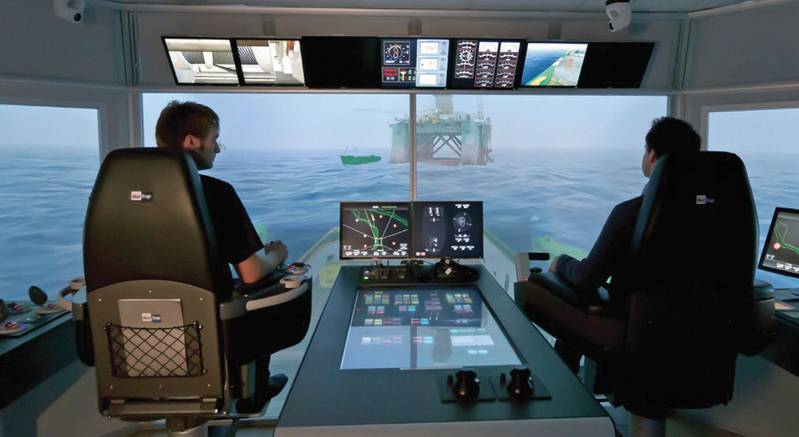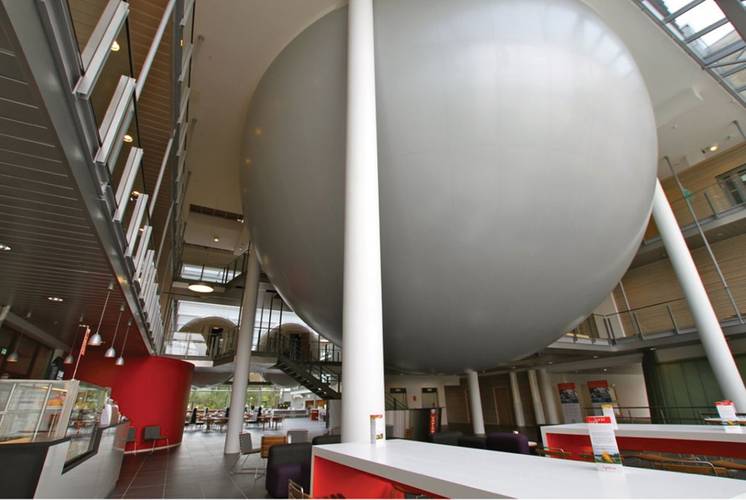OSC
Offshore Simulator Center opens in Aalesund, Norway
A new Offshore Simulator Center (OSC) is being finalized in Aalesund, Norway to provide advanced training in offshore ship operations. The new facilities are located in a 'Norwegian Competence Center building' next to the Aalesund University College.
The building contains several futuristic constructions, such as a 13.5m diameter aluminium dome for the offshore operations simulators, and two 4m diameter spherical domes for crane simulation. When finalized, the new centre will consist of one Offshore Operation Simulator, with a full 360 degree Offshore Vessel bridge, four Deck Personnel stations, a Crane Simulator, a Winch Simulator, an Engine Room Simulator, a ROV Simulator and a 360 degree 'Visualization Theatre', intended for various simulation and visualization projects, located on the lower floor of the large dome. In addition, the center will have several 'brief-/debrief rooms' with advanced audiovisual equipment that enable live transmission of sound and video from the simulators. In all, the simulators will use 70 professional grade projectors and close to 100 PCs/servers. The simulators can be operated separately or in an integrated mode, enabling advanced team training across several roles, positions or vessels.
The training courses will be provided by AAUC Maritime Operations. "This new center will enable Aalesund University College to increase the scope of simulator training, taking the training concepts to a new level. It also demonstrates some of what OSC is capable of delivering, both regarding facility design and simulator technology," Arne Monsholm, CEO at OSC told Maritime Reporter. The simulators will provide training starting mid-August this year.
Mr Monsholm described the background and business model of OSC. "Our business idea is that we want to contribute to improving the safety of the personnel through simulation and visualisation of demanding offshore operations." He describes how there is a lot of competence in offshore operations in this part of Norway, around Aalesund. OSC was founded in 2004 by Farstad Shipping, Rolls-Royce, the University College of Aalesund, and Marintek in Trondheim, each with a 25% shareholding. The first simulator was established in 2005, after which more simulators have been added. Now the entire facility is moving into new facilities.
The initializing factor of OSC was a fatal offshore accident, which took place due to a lack of knowledge and right training, in Brazil. Anchor handling was really the initial activity when the simulator center was funded. Anchor handling involves several roles and a several different actions that can go wrong. There has been fatal accidents both onboard vessels and entire vessels that have capsized. We are focusing on the operation of the offshore activities. The deck personnel has an equally important role as the people on the bridge in manoeuvring the ship. Another area OSC focuses on is supply vessel operations. "They are not as dangerous as anchor handling, because there are not as many things that can go wrong, but still, it can be a challenging operation from a coordination and a collaboration point of view." This simulation includes the lifting operation, loading and offloading of cargo, the coordination of hoses and stuff between the rig and the supply vessel. There are a lot of tasks that are important for the crew to understand." The third area OSC focuses on is crane simulation or lifting operations. There are both rig crane simulators, relevant for supply vessel operations and also subsea crane simulation, for positioning subsea equipment down on the seafloor.
The deck personnel play an important role in the simulators. They are operated like in a computer game doing the real tasks required using a joy-stick. The personnel is seen live from thosee on the bridge and they communicate like in real operations.
A large portion of the revenue of OSC is spent on research and development. Mr Monsholm presents a slide showing growing revenues reaching some NOK 41m oin 2011, of which the R&D investments represent some NOK24m. The other parts are cost of goods, when we deliver simulators to other companies, and administration. "So far, the owners say that they have not invested in OSC in order to make money. That was not the intention." OSC has 17 employees in Aalesund, and owns 60% of a company in Holland, Ivory Lake B.V., which does the graphics needed for the simulators based on a gaming engine Quest 3D owned by Act-3D B.V. holding the remaing shares in that company. OSC does its own software development. "We are connecting up DP systems, manouvering handles touch-screens, mapping systems, radars, all kind of hardware and software that typically is onboard a ship, we connect thast into our simulators and read the signals from those and send them signals back so that they beleive they are onboard a real vessel." This software is combined with the virtual world of the 3D game engine. "The difficult thing is producing the mathematical modeling, not the 3D world," Monsholm said.
The design department designs the visualization system, or how the visual world is going to be presented. To provide realism, there are 50 projectors in the large dome, of which 27 for the upper bridge, in order to provide a full 360 deg. view. OSC has developed technology to develop an combine the images so that they look correct, although the surface they are projected on is non-linear, also providing edge blending. The simulator also includes an instructor station where everything is controlled, including weather and wave conditions, time of day, etc. The trainig scenarion is directed from the station, with eventual failures provided to add realism in the training scenario. In the server room there will be between 80 and 100 computers serving the simulators.
The training concepts used for the simulator training have been developed by OSC and Aalesund University College, and are recognized worldwide as the market-leading solution for team-based simulator training for offshore operations. There are two persons in the instructor station, a Ship's Master in charge of the entire simulation, and another person looking at the human factors, the team performance, focusing on the psychology part. "This concept with two instructors and strong focus on team performance, that has been a success for us," Monsholm said. Half of the crew is actively observing the operations of the other half of the crew, from the observer room. After a debriefing, they switch.
OSC designs and supplies simulators for external companies and institutions. These also include crane simulators and small onboard trainers for safer deck operations, called SDO trainers. Every time Rolls-Royce sells an anchor handling deck crane, OSC supplies a simulator onboard the vessel. DP simulation stations and visualization can be supplied with the equipment from several suppliers, such as Rolls-Royce, Kongsberg, L3 Communications, and Marine Technologies.
External Simulator Deliveries
OSC has, sofar, delivered Anchor Handling Simulators to Bourbon in Marseilles and Singapore, the Farstad Shipping in Peth, to Rolls-Royce in Aalesund, and a naumber of Crane Simulators and smaller installations. "We have not reached the critical mass yet (regarding external sales), but are not that far from it," Monsholm described.
In December last year OSC completed the world's largest Offshore Simulator Centre, as part of Farstad Shipping's new offshore training in Perth, Australia. The centre is one of the biggest and most advanced offshore training centres in the world, with two offshore operation simulators for anchor handling and platform supply vessel operations, a crane simulator, a winch simulator, six deck personnel stations, an engine room simulator and a complete dynamic positioning (DP) training facility.
The Offshore Operation Simulator consist of two full mission offshore bridges with 360 degree field of vision, located inside a large dome construction delivered by Spitz Inc., USA. The visual system in the dome consists of 38 professional grade projectors from Projection Design, Norway. Together with OSC's top-notch 3D graphics and next-to-real simulation functionality, the solution gives unprecedented realism for personnel being trained in the simulators.
The Centre also includes an Engine Room simulator, supplied together with Polish company Unitest. It consists a full 3D walk-through engine room including a control room with controls, and switchboards using touch screen technology.
Another recent delivery is the Offshore Simulators for the new Rolls-Royce Marine Technology and Training Centre in Aalesund, Norway. The delivery includes a full 360-degree Offshore Vessel Bridge and 4 standalone Winch Simulators based on the OSC Small Dome visualization solution.
The vessel bridge solution includes a bridge house construction with a curved fibreglass projection screen wrapped around it, 22 professional grade projectors, an instructor station and more than 30 PCs/servers. The solution has been approved by Nautical Institute as a Class B DP Bridge. Rolls-Royce Marine will be using the new simulators for Rolls-Royce Marine product training.
The latest development of OSC includes joint simulation scenarios, called integrated operations, with several simulators which can be located anywhere. This could be, for example, combining two anchor handlers, the rig bridge and rig crane simulator into one big scenario.
According to Mr Monsholm, there are worldwide two, perhaps three competitors in anchor handling simulation. In the crane simulation area there are many, at least five. OSC is the only simulator combining bridge simulation with real simulated deck operations.
(As published in the November 2012 edition of Maritime Reporter - www.marinelink.com)















